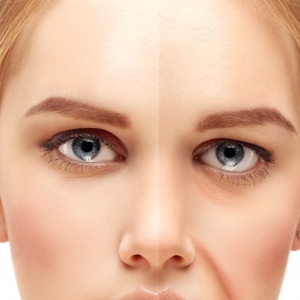
Dr. Kevin McKerrow
DERMATOLOGIST
+ SEE BIO
The goal of aesthetic treatment is to make you look brighter and more youthful. As we age, our face loses volume, which results in facial sagging, hollow areas and wrinkles.
In addition, dark circles form under the eyes, cheeks begin to sag and the folds between your nose and the corners of your mouth become more noticeable. Frown lines and lip lines appear as well. A quick assessment is all that is required to calculate a patient’s age by looking at his or her face and one way to improve volume loss is to inject fillers into areas of your face that have lost volume due to ageing.
When addressing concerns such as volume loss, wrinkles and facial sagging, the approach that will produce the quickest result is full facial correction using multiple syringes of filler. If your facial skin sags, you may think you need a skin tightening procedure or even a face-lift to correct the problem, when in fact what you may actually need is a procedure that replenishes the volume that created the sagging in the first place.
At the Skin Specialist Centre we prefer hylauronic acid fillers, such as Restylane® and Juvederm® because they look and feel natural when injected. Hyaluronic acid fillers have many advantages. Firstly, hyaluronic acid is a natural component of our skin and is a soft gel that surrounds and cushions the structural collagen molecules. Another is that the treatment is reversible, meaning that if a problem arises we can inject an enzyme (Hyaluronidase) that breaks down the injected hyaluronic acid, thus neutralising the problem. The third advantage is that hyaluronic acid fillers have a long safety record.
Our goal is to achieve complete correction with the initial treatment. This makes it easier to maintain the correct volume. Maintenance treatments are needed every six to twelve months as during the maintenance period some of the filler is re-absorbed by the body, but some remains in the corrected area. Over time the amount of filler needed for maintenance decreases, which reduces treatment, down-time and saves money.
If you want to look less tired, reduce wrinkles or improve the shape of your face, you may benefit from filler treatment. Fillers improve the cosmetic appearance of smile lines, frown lines, cheek wrinkles, thin or wrinkled lips, under-eye hollows or dark circles and scars, and can also result in a more lifted look and reduce the appearance of jowls and sagging.
Achieving improvement that looks natural is the key to your treatment. You can expect a more youthful facial appearance that is consistent with the way you look now in your age range, as the lost volume of key areas described above are filled with hyaluronic acid. The transformation may be profound or subtle, but looks natural and is safe. Family and friends often notice a change, but may not be able to identify it.
The benefits of hyaluronic acid fillers are temporary. You can expect improvements to last for four to twelve months with Restylane® and Juvederm®. Maintenance usually consists of one to two visits per year for touch-ups. Permanent fillers are available, but these are silicone or plastic and do not occur naturally in the human body. These materials can cause a delayed allergic reaction up to ten years after placement, and if this happens the filler must be removed by surgery. Permanent fillers may also migrate to a different part of your face. For these reasons, the Skin Specialist Centre believes that temporary fillers that are naturally absorbed and processed by your body are safer options than permanent fillers. However, pregnant women or persons with allergies to filler ingredients should not receive any kind of injectable fillers, even temporary ones.
Treatable areas include:
When injected, these fillers enhance volume, erase wrinkles and augment lips. The active ingredient in each of these products is hyaluronic acid, a protein prepared from a similar protein that occurs naturally in our skin. In its natural state, hyaluronic acid surrounds collagen, a structural protein that resembles a rope in the length, flexibility and hardness. By coating collagen and other structural proteins, hyaluronic acid acts as a cushion for our skin. The natural occurrence of hyaluronic acid is one of the reasons this substance is used as a filler.
Although uncomfortable, we find the majority of our patients find the procedure to be much more tolerable than they imagined. The hyaluronic acid fillers contain anaesthetic and the majority of our patients tolerate the procedure well. The filler is injected slowly into each of the treated sites. For additional comfort, we can direct cold air onto the target area during injection, and we often use cannulas (blunt tip applicators) to minimise discomfort and bruising. If we treat your lips (which may be more sensitive) we may use additional anaesthetic.
Bruising and swelling and some discomfort are expected. We inform patients to prepare for two to three days of down-time, but occasionally that can extend to two weeks, and very rarely beyond. We do have a laser treatment that we can offer if bruising is significant which reduces the down-time (Candela VBeam). Occasionally, the material clumps in one place, resulting in a lumpy feeling in that area. This can be corrected by massaging the lumpy area, although sometimes this naturally corrects without any intervention within two weeks. If this does not work, it may be necessary to inject Hyaluronidase, an enzyme that breaks down the injected hyaluronic acid. The target area must be treated again when the lump has resolved. This is why we usually recommend a two week follow-up so we can smooth out such irregularities if they are present, as well as make sure you are satisfied with the aesthetic result. Prior to treatment, all potential risks and side-effects will be discussed with you by your dermatologist.
The treatment area will be swollen, red and bruised. We recommend regularly applying ice to the treated area after the procedure. You may put on make-up immediately, although swelling and redness last 2 – 5 days, and possibly one week longer. Numbness from the anaesthetic may persist for one to two hours. We ask you to return in two weeks to evaluate your improvement and satisfaction. To minimise bruising, we suggest you avoid Aspirin and Aspirin-related products, and non-steroidal anti-inflammatory drugs (Ibuprofen), along with homeopathic treatments such as Omega 3 and flaxseed oil, for two weeks before the procedure. No other special precautions are necessary. If you have a history of cold sores on your face, please let us know so that we may pre-treat you with antiviral medication.
To improve wrinkles, other options include botulinum toxin, fractionated CO2 (Smart Xide Dot laser resurfacing), Fraxel Restore Dual, eTwo Sublative treatment or a surgical face-lift.
Yes, for example botulinum toxin may be injected during your visit for fillers. Botox helps to correct the upper third of your face, while fillers help with the lower two-thirds. This combination is widely used because it provides considerable aesthetic improvement in only one to two weeks. If filler injections are combined with high density laser treatment, we usually wait one month after filler injection to use the laser, to prevent overheating the filler treated area.